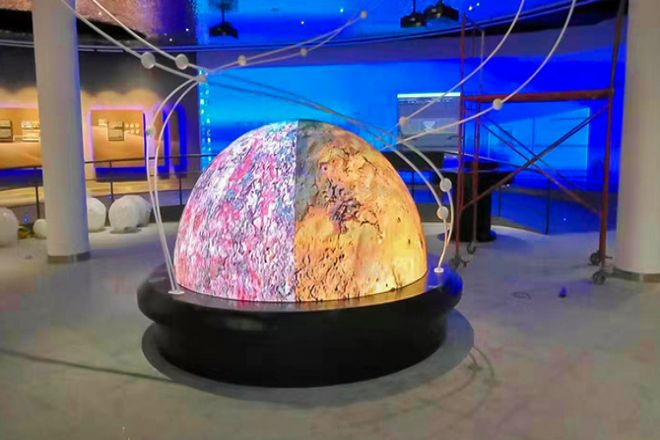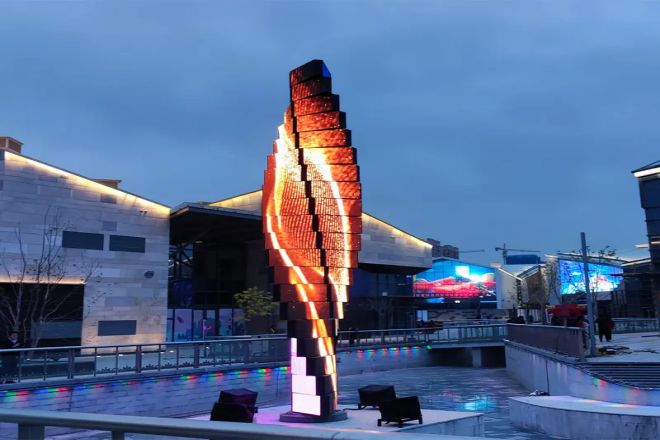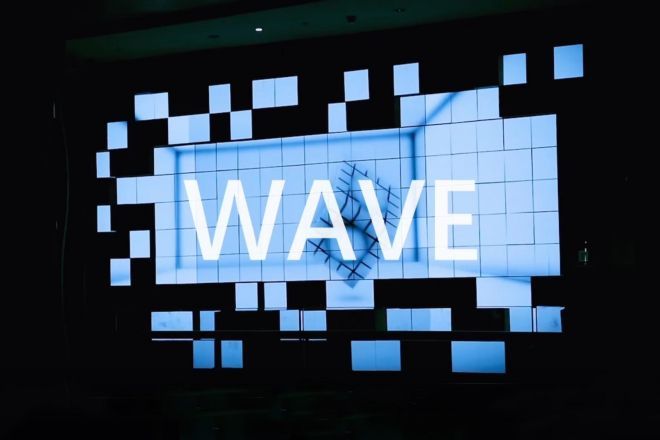Introduction

In today’s world of rapid technological development, LED display screens, as the shining pearl of digital display technology, are changing our visual experience and information dissemination methods at an unprecedented speed. From giant billboards on the city skyline to the delicate picture quality of home entertainment, LED display screens have penetrated every corner of social life with their unique charm.
However, with the continuous advancement of technology and the increasing diversification of market demand, traditional LED display screens have been unable to meet the needs of all scenarios. Therefore, innovative LED display screens are not only an inevitable trend of technological development but also an urgent requirement for industry transformation and upgrading to meet future social needs.
1. Current situation analysis: opportunities and challenges in the LED display screen industry
- Market demand surges
Globally, the market demand for LED display screens has shown an explosive growth trend. This trend is mainly due to its wide application in many key fields.
In the field of advertising media, LED display screens have become the preferred publicity media for outdoor advertising, commercial buildings, shopping centers, and other places, with their high brightness, high definition, and easy control, greatly enhancing the communication effect and visual impact of advertising.
In terms of sports events, large LED screens have become the highlight of the venues, bringing an immersive viewing experience to the audience and providing a valuable display platform for event sponsors.
In addition, as part of the urban landscape, large outdoor screens not only carry the function of information dissemination but also become an important display window for urban culture and commercial activities.
The conference and exhibition field uses the flexibility and interactivity of LED screens to provide exhibitors and audiences with richer ways of display and communication. The wide application of these fields has brought huge market growth space for the LED display industry.
- Driven by technological progress
The rapid development of the LED display industry is inseparable from the continuous progress of technology. In terms of LED chip technology, with the continuous maturity of new technologies such as Mini/Micro LED, the performance indicators of LED display screens, such as resolution, brightness, and color saturation, have been significantly improved.
These new LED chips have smaller size, higher luminous efficiency, and better color consistency, allowing the display screen to present more delicate and realistic picture effects. At the same time, the continuous innovation of drive control systems and image processing technology also provides strong support for the performance improvement of LED display screens.
Advanced drive control systems can achieve more precise pixel control and brightness adjustment, while efficient image processing technology can optimize image quality, reduce noise and distortion, and enhance the audience’s visual experience.
- Challenges
Although the LED display industry faces huge market opportunities and technological progress, there are also some challenges that cannot be ignored. First, cost control is one of the key issues in the development of the industry.
With the fluctuation of raw material prices and the increase in labor costs, the production cost of LED displays continues to increase, which puts pressure on the profitability of enterprises.
Secondly, energy consumption is also an industry focus. Although LED displays have the advantage of lower energy consumption compared to traditional display devices, as the size and brightness of the display continue to increase, its energy consumption is also gradually increasing.
How to reduce energy consumption while ensuring the display effect has become an urgent problem that needs to be solved in the industry. In addition, there are also challenges in visual comfort, installation, maintenance difficulties, etc.
Watching high-brightness LED displays for a long time may cause discomfort to the audience’s eyes, and the installation and maintenance of large displays require professional technical and equipment support, which increases the operating costs of enterprises.
2. The necessity of innovative LED display screens

- Meet the needs of diversified application scenarios
With the continuous advancement of science and technology and the rapid development of society, the application scenarios of LED display screens are becoming increasingly diversified, covering multiple fields such as advertising media, sports events, outdoor large screens, conferences and exhibitions, cultural education, entertainment venues, and even smart homes.
Each field has its own unique needs and challenges, which require LED display screens to be highly customized, intelligent, and flexible. Innovative LED display screens can adjust screen size, resolution, brightness, color, and other parameters according to the specific requirements of different scenarios and even integrate interactive elements and intelligent control functions to better meet user needs and enhance the overall effect and value of application scenarios.
- Improve user experience
User experience is one of the important criteria for evaluating the quality of LED display screens. Through technological innovation, LED display screens have achieved a qualitative leap in visual effects.
High refresh rate technology can reduce screen smear and blur, making dynamic images smoother and more natural; wide viewing angle technology ensures that the audience can get a clear and consistent visual experience at different angles; HDR (high dynamic range) technology further enhances the color layering and contrast of the picture, making the picture more realistic and vivid.
These technological innovations not only enhance the visual effects of LED display screens but also bring users a more immersive viewing experience, enhancing users’ sense of participation and satisfaction.
- Promote sustainable development
Driven by the global green development trend, environmental protection, and energy conservation have become the focus of attention from all walks of life. The LED display industry is no exception. Innovative LED display screens are committed to developing low-energy, environmentally friendly materials, and recyclable products to reduce the impact on the environment.
By optimizing the LED chip structure, improving the drive control system, and adopting new heat dissipation materials, the energy consumption of LED display screens can be effectively reduced; at the same time, the use of environmentally friendly materials and recyclable design solutions can reduce the generation of waste and the waste of resources.
These measures not only meet the requirements of the global green development trend but also provide strong support for the sustainable development of enterprises.
- Enhance market competitiveness
In the fierce market competition, innovation is the key for enterprises to stand out. For the LED display industry, only continuous innovation can maintain its leading position and attract more customers and market share.
Through technological innovation and product upgrades, enterprises can launch more competitive LED display products to meet the needs of the market and users. These products are not only superior in performance, more fashionable, and beautiful in appearance and design but also have higher cost performance and better after-sales service.
These advantages will help companies win the trust and favor of customers, thereby occupying a favorable position in market competition.
3. Innovation direction and strategy
1). Technological innovation
1.1). Micro LED and Mini/Micro LED technology:
- Potential exploration:
Micro LED and Mini/Micro LED technology are hot spots in the current LED display field. These new technologies significantly improve the resolution of the display by reducing the size of the LED chip, making the picture more delicate and clear.
At the same time, due to the reduction in the size of the LED chip, power consumption is also reduced accordingly, which helps achieve the goal of energy conservation and emission reduction.
In the future, we should continue to study these technologies in depth, solve their problems in packaging, driving, heat dissipation, etc., and further explore their potential to improve resolution and reduce power consumption.
1.2). Flexible display technology:
- Application expansion:
Flexible display technology is another major innovation direction in the field of LED display. This technology enables the display to bend, fold, or even curl, thereby broadening the application scenarios of LED displays.
For example, in the fields of wearable devices, curved screens, flexible billboards, etc., flexible LED displays show great application potential.
In the future, we should increase investment in the research and development of flexible display technology, improve its performance in durability, flexibility, display effects, etc., and promote its commercial application in more fields.
1.3). Intelligent control system:
- Intelligent upgrade:
Using advanced technologies such as AI and the Internet of Things to improve the intelligence level of LED display screens is an important trend in the development of the industry.
Through the intelligent control system, remote monitoring, automatic dimming, content push, and other functions of the display screen can be realized to improve management efficiency and user experience.
In the future, we should continue to deepen the application of technologies such as AI and the Internet of Things in the field of LED display screens, develop more intelligent and convenient control systems, and provide users with a more personalized service experience.
2). Design and manufacturing innovation
2.1). Modular design:
- Flexibility and maintainability:
Modular design is an effective way to improve the flexibility and maintainability of LED display screens. By dividing the display screen into multiple independent modules, it can be easily replaced, upgraded, and maintained.
At the same time, modular design also helps to reduce production and transportation costs and improve the market competitiveness of products.
In the future, we should continue to optimize the modular design scheme, improve the versatility and compatibility of the modules, and promote the popularization and application of modular design.
2.2). Lightweight materials:
- Convenience improvement:
The use of lightweight materials is an important means to reduce the weight of LED display screens and reduce transportation costs. Lightweight materials not only help simplify the installation process and improve installation efficiency but also help reduce the requirements and costs of building structures.
In the future, we should actively explore the application of new lightweight materials, such as carbon fiber, aluminum alloy, etc., to improve the convenience and economy of LED display screens.
2.3). Application of environmentally friendly materials:
- Green production:
The use of environmentally friendly materials in the production process of LED display screens is an important measure to reduce environmental pollution and achieve green production. The application of environmentally friendly materials helps to reduce the emission of harmful substances and the generation of waste, as well as reduce the negative impact on the environment.
In the future, we should increase investment in the research and development and application of environmentally friendly materials to promote the green transformation and sustainable development of the LED display industry.
3). Market and service innovation
3.1). Customized service:
- Personalized demand satisfaction:
Providing personalized solutions according to customer needs is an important means to improve customer satisfaction and market competitiveness. Through customized services, we can meet customers’ special needs in terms of size, shape, color, function, etc., and provide LED display products that are more in line with customer needs.
In the future, we should strengthen communication and cooperation with customers, deeply understand customer needs and market trends, and continuously improve the ability and level of customized services.
3.2). After-sales service upgrade:
- Customer experience optimization:
Establishing a rapid response mechanism and improving customer satisfaction are important goals of after-sales service. By providing timely and professional after-sales service support, we can promptly solve the problems and difficulties encountered by customers during use and enhance customers’ trust and loyalty to products and brands.
In the future, we should continue to optimize the after-sales service process and service quality, improve service response speed and service efficiency, and provide customers with a better after-sales service experience.
3.3). Cross-border cooperation:
- Industry collaborative development:
Establishing cooperative relations with upstream and downstream industrial chain enterprises, scientific research institutions, etc., is an important way to promote technological innovation and industrial upgrading.
Through cross-border cooperation, we can integrate the resources and technological advantages of all parties to jointly promote the development and progress of the LED display industry.
In the future, we should actively seek cooperation opportunities with upstream and downstream industrial chain enterprises and scientific research institutions, strengthen industry-university-research cooperation and technical exchanges, and jointly promote the innovation and application of LED display technology.
4. Possible results

After implementing the above-mentioned innovation directions and strategies in the LED display industry, the following results may occur:
- Technological breakthroughs and market leadership:
The successful application of micro-LED and Mini/Micro LED technology will significantly improve the resolution and energy efficiency of the display, enabling enterprises to maintain a leading position in technology and may lead the formulation of industry standards.
The maturity of flexible display technology will open up new market areas, meet the needs of specific industries (such as wearable devices, automotive interiors, etc.) for curved or deformable displays, and enhance the market competitiveness of enterprises.
The popularization of intelligent control systems will enhance user experience, realize intelligent management of display screens, and provide data support for enterprises to optimize operation strategies.
- Improved design and manufacturing efficiency:
The application of modular design will simplify the production process, reduce production costs, improve the maintainability and flexibility of products, and meet the diverse needs of customers.
The application of lightweight materials and environmentally friendly materials will reduce resource consumption and environmental pollution in the production process while reducing transportation and installation costs and improving the economic and social benefits of enterprises.
- Market expansion and customer satisfaction improvement:
The introduction of customized services will better meet the personalized needs of customers, improve customer satisfaction and loyalty, and thus promote the growth of market share.
The upgrade of after-sales service will improve the efficiency of solving customer problems, enhance customer trust, and lay a solid foundation for the long-term development of enterprises.
- Collaborative development of the industry and construction of an innovative ecosystem:
Cross-border cooperation will promote resource integration and technical exchanges between upstream and downstream enterprises in the industrial chain, and promote collaborative innovation and technological progress in the entire industry.
The cooperation of scientific research institutions will provide enterprises with cutting-edge technical support and talent guarantee, accelerate the transformation and application of technological achievements, and promote the development of the industry to a higher level.
- Sustainable development and green transformation:
The development of low-energy consumption, environmentally friendly materials, and recyclable LED display products will be in line with the global green development trend and help enterprises achieve sustainable development goals.
These environmentally friendly products will be favored by more and more consumers, establish a good image for enterprises in the market, and enhance brand value.
However, it should be noted that the innovation process may also face challenges, such as technical bottlenecks, low market acceptance, and rising costs.
Therefore, when implementing innovation strategies, enterprises need to fully evaluate factors such as market demand, technical feasibility, and cost-effectiveness and formulate scientific and reasonable innovation plans and implementation plans.
At the same time, strengthening internal management, talent training, and team building are key factors that ensure the success of innovation.
Conclusion
In short, innovative LED display is the mission given to us by the times, and it is also the inexhaustible driving force for the sustainable development of the industry.
In the wave of scientific and technological revolution, we should be brave to take responsibility, dare to break through, and constantly explore the boundaries of LED display technology to promote its development in the direction of higher quality, higher efficiency, and environmental protection. At the same time, we should also pay attention to changes in market demand, actively adjust product strategies, and provide customized solutions that better meet user needs.
Finally, if you want to know more about LED display screens, please get in touch with us.
